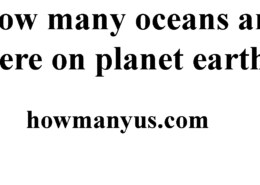How many oceans are there on planet earth?
The question “How many oceans are there on planet Earth?” might seem like a basic inquiry. Yet, it sparks curiosity about our planet’s geography and highlights ongoing scientific debates. Understanding the number of oceans offers a deeper appreciation for Earth’s vast hydrosphere and its influence on global climate patterns. This question goes beyond a simple numerical answer, prompting us to explore varying perspectives on how we classify Earth’s major bodies of saltwater.
Diving Deeper: The Scientific Lens and Oceanographic Classifications
Several factors influence how many oceans we recognize on Earth:
-
All-Encompassing Ocean View: From a purely scientific perspective, Earth possesses a single, interconnected global ocean. Ocean currents continuously circulate throughout this unified body of saltwater, distributing heat and nutrients across the planet.
-
Geographical Divisions: For practical purposes, oceanographers often divide the global ocean into larger geographic regions based on continental boundaries, water properties (like temperature and salinity), and surface currents. These divisions serve as reference points for geographical studies and discussions about marine life and ecosystems.
-
Historical Context: Traditionally, five named oceans have been recognized: the Pacific, Atlantic, Indian, Arctic, and Southern Oceans. These classifications have historical significance and remain widely used in educational contexts.
How many oceans are there on planet earth?
Exploring the Five-Ocean Model: A Widely Recognized System
The five-ocean model is the most commonly used classification system for Earth’s oceans. Here’s a breakdown of these major divisions:
-
Pacific Ocean: The largest and deepest ocean, encompassing nearly one-third of Earth’s surface.
-
Atlantic Ocean: The second-largest ocean, separating the Americas from Europe and Africa.
-
Indian Ocean: Situated between Africa, Asia, Australia, and Antarctica, known for its unique water circulation patterns.
-
Arctic Ocean: The smallest ocean, surrounding the North Pole and characterized by polar ice caps.
-
Southern Ocean: Encircling Antarctica, this recently recognized ocean plays a critical role in global ocean circulation and climate regulation.


Our planet’s expansive hydrosphere presents a captivating question: How many oceans exist? This guide illuminates the scientific perspective on Earth’s interconnected global ocean and explores the widely used five-ocean classification system, along with the opposing one-global-ocean viewpoint.
Understanding Ocean Classification:
The Five-Ocean Model: